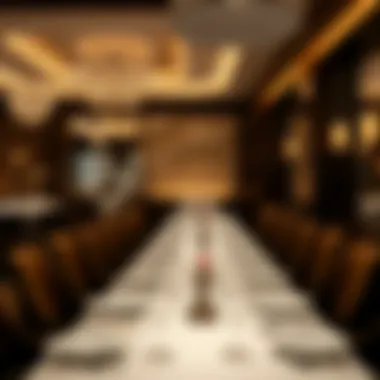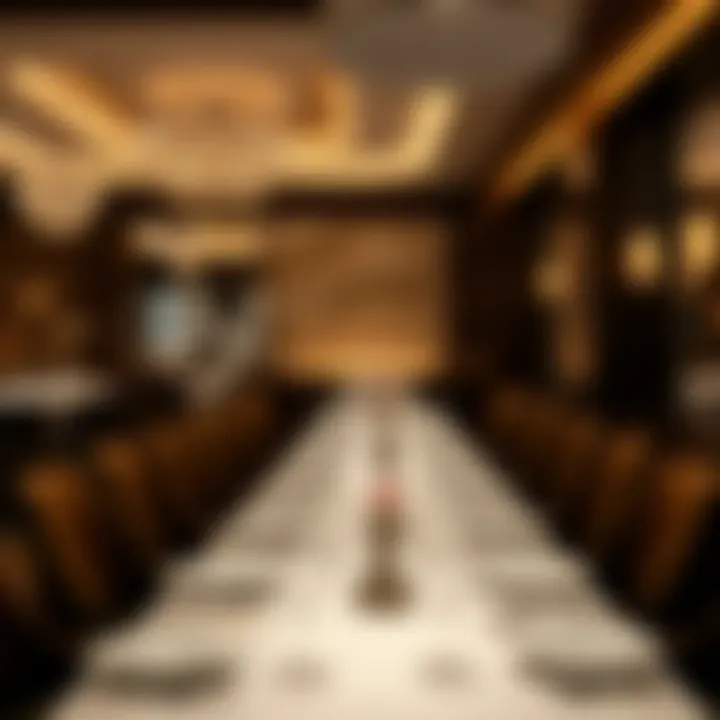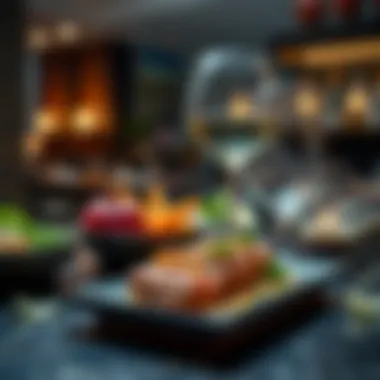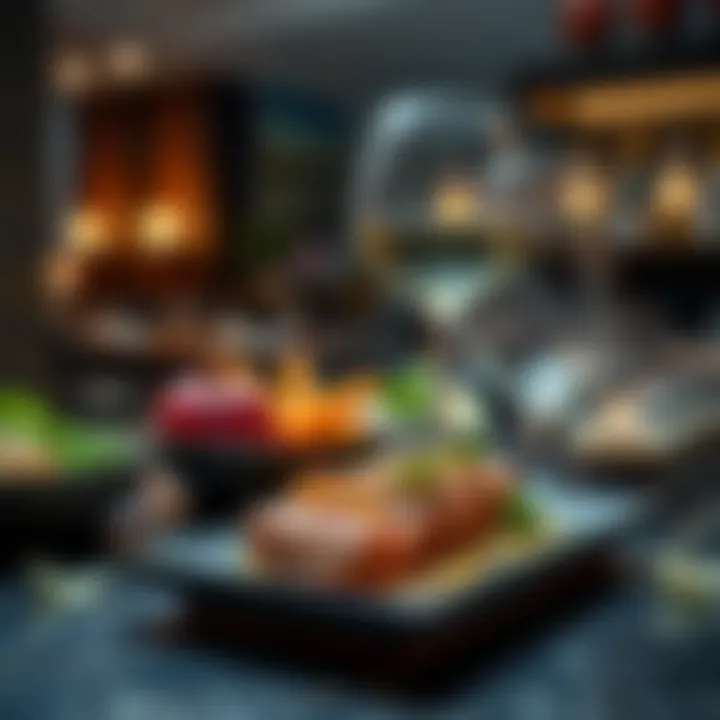Experience Dubai's Two Michelin Star Dining Gems


Intro
Dubai's culinary scene has evolved into a remarkable tapestry of flavors, with two Michelin-star restaurants at the forefront, showcasing exquisite gastronomy. In this bustling metropolis, the rich blend of cultures nourishes creativity, leading to dishes that are not only visually stunning but also unforgettable in taste. Michelin stars have become synonymous with high standards, and the two establishments under our spotlight exemplify what it means to marry tradition with innovation.
Visiting a Michelin-starred restaurant is not just about the meal; it is a full-fledged experience that caters to all senses. The ambiance, service, and, of course, the carefully curated dishes provide a glimpse into the chef’s vision and the kitchen's meticulous attention to detail. By diving deeper into these key venues, we unveil the philosophies that drive the culinary masters behind each restaurant. Understanding their approach offers patrons a richer appreciation of the craftsmanship involved in haute cuisine, elevating dining beyond mere sustenance.
In this article, we will explore the distinctive characteristics of these two restaurants. From signature dishes crafted with premium local ingredients to the cultural influences that shaped their culinary philosophies, each layer reveals the complex and dynamic nature of Dubai's fine dining scene. So, let's embark on a journey through enticing aromas and breathtaking presentations, where flavors tell a story and dining is an art form.
"A meal without wine is like a day without sunshine."
As we delve into this exploration, we aim to provide insights that not only inform but also inspire food enthusiasts and gastronomes alike to appreciate the nuances that shape the Michelin-star experience in Dubai.
Prologue to Dubai's Culinary Scene
Dubai's culinary landscape is nothing short of a dazzling spectacle. The city has transformed itself from a modest gathering of nomadic tribes to a bustling metropolis that celebrates culinary diversity like no other place in the world. This shift not only signifies an explosion of choice but also reflects the city's ambition to be a global gastronomic hub. From street food stalls offering tantalizing shawarma to elegant fine dining establishments, Dubai's varied food offerings cater to every palette and pocket.
In examining Dubai’s culinary scene, one discovers how the local culture has marshed into a melting pot of flavors. The influx of international talent—from chefs to restaurateurs—has led to a game-changer in the dining eperience. Now found in the heart of Dubai are restaurants that showcase everything from Middle Eastern traditions to avant-garde fusion creations. Investors, homebuyers, and expats are particularly interested in this evolution as it signifies a thriving economy where culinary innovation contributes to the broader cultural identity.
Understanding this environment is critical for appreciating the fine dining options that have garnered Michelin recognition in the city. The Michelin star has become synonymous with excellence in the dining world, and to have not one, but two Michelin-starred restaurants in Dubai, speaks volumes about its culinary stature. This article aims to showcase the high points of these prestigious institutions, but first, one must grasp the background.
The Evolution of Fine Dining in Dubai
The evolution of fine dining in Dubai can be traced back to its early days as a trade hub, where spices and flavors from across the globe converged. As oil wealth poured into the emirate in the 20th century, an increasing number of luxury hotels and high-end restaurants sprang up. Culinary elites from around the world seized the opportunity to set up shop in Dubai, turning it into a playground for gastronomy.
As time rolled on, the fusion of various cuisine styles began to emerge. Traditional dishes took on modern interpretations, leading to a new breed of chefs who dared to challenge the status quo. Nowadays, it’s not unusual to find Mediterranean-inspired dishes paired with traditional Arabic flavors or Asian influences dancing through European-classic formats. This fluidity has added layers to Dubai's culinary character, making it a true gastronomic adventure that beckons food lovers from near and far.
“Dubai’s culinary scene is living proof of how tradition and modernity can coexist harmoniously. Every bite tells a story of influence and innovation.”
Understanding the Michelin Guide
When discussing fine dining, the Michelin Guide often commands immediate attention. Established in 1900 by the tire company Michelin, the guide began as a simple travel companion for motorists, eventually morphing into the definitive benchmark for culinary excellence. Star ratings—now considered the Holy Grail for chefs—are awarded to restaurants based on a strict set of criteria. To earn a Michelin star signifies that a restaurant serves high-quality food, with two stars indicating exceptional cuisine that is worth a special journey.
In the context of Dubai, the Michelin Guide’s introduction was a pivotal moment for the city’s dining landscape. It validated the culinary talents thriving in the region while highlighting the city’s commitment to global dining standards. The presence of Michelin-rated restaurants can be a significant lure for investors and homebuyers, as these venues often enhance the appeal of surrounding neighborhoods. As the guide continues to expand its global reach, the recognition of two-star establishments in Dubai may not only affect the local gastronomic scene but could also contribute to its long-term economic growth.
There's something exciting in watching how the culinary scene in Dubai morphs, with more chefs aspiring to steer their establishments towards that coveted Michelin star. The journey to attaining such a distinction speaks to the passion behind culinary craftsmanship.
With this foundation laid, we can now dive into the specific Michelin star restaurants that are setting the culinary scene in Dubai ablaze.
Dubai's Michelin Star Achievements
Dubai's culinary scene has been on an impressive trajectory, marked by its recent achievements in acquiring Michelin stars. This development is not just a badge of honor for the restaurants involved; it also reflects the city’s growing status as a global culinary destination. The Michelin rating system, revered worldwide, awards stars based on quality, creativity, and the overall dining experience. Restaurants in Dubai have risen to this challenge, bringing innovative dishes and exceptional service to the forefront.
Overview of Michelin Star Ratings
The Michelin stars have become synonymous with fine dining excellence. The system generally awards:
- One Star: A very good restaurant in its category, offering a quality cuisine.
- Two Stars: Excellent cooking, worth a detour, showcasing a refined cuisine that is carefully crafted.
- Three Stars: Exceptional cuisine, worth a special journey, where the chef surpasses all expectations.
Garnering a Michelin star involves rigorous inspections, with anonymous inspectors evaluating food quality, preparation techniques, and consistency. In Dubai, the introduction of these ratings signifies a significant elevation of local gastronomy, attracting attention not only from food enthusiasts but also from investors, realtors, and food critics alike.
Significance of Two Michelin Stars
Securing two Michelin stars is a monumental achievement, setting these restaurants apart as exemplars of culinary artistry. Restaurants awarded with two stars demonstrate:
- Exceptional Quality: The hallmark of two Michelin stars is not just about artistry on the plate but also the use of top-tier ingredients.
- Innovative Techniques: The chefs at these establishments showcase avant-garde cooking methods, ensuring that each dish tells a story.
- Patron Experience: Dining at a two-star restaurant transcends just the meal; it’s about the ambiance, service, and overall experience. These venues often create a multi-sensory journey for their guests.


Michelin stars impact the restaurant's clientele, elevating its prestige and often resulting in increased bookings, higher culinary standards, and a bustling gastronomic community. For investors and food aficionados, understanding this significance reveals potential opportunities within Dubai’s maturing culinary landscape.
"A Michelin star can transform a restaurant's trajectory, influencing everything from dining trends to investment decisions."
In summary, Dubai's journey in achieving Michelin stars is more than just an accolade. It underscores a dedication to culinary excellence and innovation, positioning the city as a vibrant player on the global stage.
First Michelin Star Restaurant: Location and Concept
The culinary landscape of Dubai is not only about extravagant decor and breathtaking views; it also revolves around the concept and location of each venue. Having a Michelin star is a badge of honor, but the significance of the first Michelin star restaurant in this lavish city goes beyond mere rankings. It's about what sets it apart in a marketplace noted for its diverse dining options and extravagant settings.
Situated in a prime location, the first Michelin star restaurant captures the essence of Dubai's blend of cultures and flavors. The very site plays a role in crafting the overall dining experience. A restaurant perched by the waterfront, for instance, offers not just delectable dishes but also inspiring views of the city's skyline. Meanwhile, a cozy establishment nestled in a quiet neighborhood might exude intimacy, enhancing connection between the diners and the culinary creations presented before them.
In this article, the focus is on how the specific elements of location and concept contribute to the overall success and allure of this esteemed restaurant. Those factors can elevate the dining experience for guests and set the stage for culinary excellence. This restaurant doesn’t merely serve food; it tells a story through its design, atmosphere, and menu choices.
A Deep Dive into the Culinary Philosophy
Every Michelin star restaurant is steeped in a unique culinary philosophy that defines the dining experience. It’s not just about the food—it's a tapestry woven from tradition, innovation, and creativity. The first Michelin star restaurant embodies a passion for local ingredients, employing seasonal produce to shape its menu.
The chef’s commitment is reflected in their approach to cooking. Inspiration often springs from various influences, blending modern techniques with traditional flavors. A visit here might showcase dishes that pay homage to the rich heritage of Middle Eastern cuisine but presented with a contemporary twist. The goal, ultimately, is to erase the boundaries of what fine dining can be.
The restaurant's atmosphere complements this philosophy. With an emphasis on bringing the diners into the cooking process, the open kitchen style allows guests to watch skilled chefs at work. This transparency cultivates a space of trust and appreciation for the meticulous craft of haute cuisine.
Signature Dishes and Recommendations
When dining at a Michelin-star restaurant, the signature dishes are a highlight that often surprises even the most seasoned foodies. Each plate presents not just a meal but an artistic experience. For example, one might encounter a dish of saffron-infused risotto paired with tender lamb, highlighting the harmonious flavors that are distinctive to the region.
- Heirloom Tomato Salad: Renowned for its flavor and presentation, featuring various local tomatoes drizzled with a subtle olive oil—simple yet revolutionary.
- Seared Scallops: Often considered the restaurant’s hallmark, the scallops are prepared with a delicate hand, drawing attention to their natural sweetness while being complemented by a tangy citrus beurre blanc.
- Chocolate Fondant: To end on a sweet note, the fondant is famous not just for its taste but the experience of cracking its shell to reveal molten chocolate within.
Every dish is worth taking a picture of before indulging, though it’s advised to tuck into the culinary adventure quickly before the magic fades.
In summary, the first Michelin star restaurant in Dubai stands as a beacon of culinary excellence. Through thoughtful location, innovative culinary philosophies, and signature dishes, it encapsulates the essence of what fine dining should be—and its impact resonates beyond just the plate.
Second Michelin Star Restaurant: Ambiance and Experience
The ambiance and experience of a second Michelin star restaurant play a pivotal role not only in the overall dining experience but also in the way patrons perceive the culinary artistry presented before them. In Dubai's highly competitive gastronomic landscape, these elements can elevate a meal from mere sustenance to an unforgettable event. Patrons journey to these establishments seeking more than just exceptional dishes; they look for an immersive experience, which starts the moment they step through the door and feels as personal as the meticulously crafted menu they will soon enjoy. The atmosphere of a Michelin-starred restaurant often intertwines with the chef's vision, revealing a story behind each painting on the wall, each table setting, and each carefully selected piece of music. Therefore, understanding the intricacies of the ambiance allows diners to appreciate not just what's on their plates, but the overall narrative being presented.
Analyzing the Design and Atmosphere
The design of a Michelin-star restaurant is not simply about elegance or luxury; it is about creating an environment that complements the culinary offerings. Soft lighting casts a warm glow, while the arrangement of furniture encourages intimacy and conversation. Materials often used are high-quality, with textures that enhance the visual appeal and create an inviting atmosphere.
Elements to consider that contribute to the design include:
- Color Schemes: Warm tones tend to nurture a cozy environment, while cool tones establish a calm, sophisticated vibe.
- Seating Arrangements: Thoughtfully spaced tables offer privacy without feeling isolated. The comfort of the seating can also influence how long patrons linger.
- Artistic Touches: Local art pieces or innovative design accents can bridge the connection between the cultural heritage of Dubai and modern culinary expression.
The atmosphere can also be heavily influenced by the choice of music, acoustics, and even the scent in the air. All these factors work in harmony to ensure that every aspect of the restaurant aligns with the experience patrons are seeking.
"The ambiance is like the soft whisper that guides your taste buds, setting the scene for culinary excitement."
Exploring the Menu Curations
The menu curation at a second Michelin-star restaurant is often a reflection of its chef’s identity and philosophy regarding food. Seasonal ingredients sourced from local markets may be paired with exotic flavors, creating a culinary journey that feels both familiar and adventurous. The menus often reflect the restaurant's core values, emphasizing sustainability, innovation, and craftsmanship.
Key aspects to note about menu curations are:
- Seasonal Ingredients: Chefs are increasingly prioritizing local and seasonal produce, not just for freshness, but to support local farmers and reduce their carbon footprint.
- Signature Dishes: Dishes that stand out often become synonymous with the chef's name, offering patrons something unique that cannot be easily replicated elsewhere.
- Tasting Menus: Many Michelin-starred locations opt for tasting menus, allowing diners to embark on a curated adventure through the chef’s vision. This approach not only showcases a range of flavors but also provides an intimate look into the thought process behind each dish.
This careful crafting of the menu emphasizes both the ingredients and the cooking techniques used, creating a multi-layered experience that delights the senses. Diners leave these culinary havens feeling enriched and inspired, not just by the meal itself but by the entire ambiance and artistry surrounding it.


For more insights into Dubai's culinary offerings, you can check out resources like Wikipedia and Britannica for a deeper understanding of the Michelin ratings and their significance in fine dining.
Chef Profiles Behind the Michelin Stars
Understanding the chefs behind Dubai's Michelin-starred restaurants offers profound insight into the culinary artistry that defines these luxurious venues. Michelin stars aren't merely awarded for the taste of food; they're a reflection of a chef's journey, their inspirations, and their relentless pursuit of excellence. The culinary landscape in Dubai thrives because of these innovative minds, who not only create exceptional dishes but also weave stories through their work.
It's critical to recognize that a chef's background often shapes the dining experiences they provide. From their early culinary education to the myriad kitchens they have traversed, each chef carries a unique narrative that influences their culinary style. Exploring their profiles not only illuminates the factors that drive their creativity but also highlights the passion and commitment required to achieve and maintain Michelin status.
Chef's Journey and Inspirations
The path to becoming a Michelin-starred chef is often anything but straightforward. Many chefs come from humble beginnings, spending years honing their skills before reaching the pinnacles of success. Take Chef Tarek Ibrahim from restaurant Nobu, for instance—his culinary journey began in a modest kitchen in Lebanon. Through determination and a quest for knowledge, he worked under renowned chefs across Europe and Asia. His experiences working at various prestigious establishments have profoundly impacted his cooking style, blending cultural traditions seamlessly with modern techniques.
Moreover, inspirations often stem from personal experiences. Some chefs draw from their childhood memories, like Chef Aida of Zuma, who channels flavors reminiscent of her grandmother’s home cooking. Unique journeys are pivotal in developing distinctive flavors that grace their menus. Their inspirations merge their cultural heritage with global influences, inviting diners to embark on a culinary expedition filled with taste and tradition.
Innovative Techniques and Ingredients
At the essence of fine dining is the innovative spirit that chefs employ in their kitchens. The quest for perfection often leads to pioneering techniques and the exploration of unusual ingredients. For instance, Chef Gregoire Berger from Ossiano is known for his avant-garde approaches to seafood. With a background in molecular gastronomy, he crafts dishes that are not only a feast for the palate but also a visual delight, pushing the boundaries of traditional methods.
- Locally Sourced Ingredients: Many chefs prioritize farm-to-table sourcing, showcasing local produce that reflects the region's flavors. This approach not only supports sustainability but also creates seasonal menus that change throughout the year.
- Technique Mastery: Techniques like sous-vide, where food is vacuum-sealed and slow-cooked in water baths at precise temperatures, elevate the dining experience. This method, embraced by many Michelin chefs, ensures that each dish not only retains its moisture but also blossoms with flavor.
In an industry where innovation is key, chefs are constantly experimenting with spices, textures, and presentations. The meticulous attention to detail reflects their dedication to creating exceptional experiences for diners. These elements turn each meal into an intricate dance of flavors, ensuring that every bite is memorable—a hallmark of Michelin-star excellence.
The journey of a Michelin-star chef is not just about food; it's about expressing identity through culinary art, where every dish tells a story.
By delving into the profiles of these chefs, we uncover the heart and soul behind the Michelin stars. Their stories resonate with ambition, creativity, and an unyielding commitment to excellence in the culinary arts.
Dining Etiquette at Michelin Star Venues
When stepping into a Michelin star restaurant, it’s not just about savoring exceptional cuisine; it’s also about understanding the nuances of dining etiquette that elevate the experience. This understanding not only enhances the personal enjoyment of a meal but also pays respect to the chef's art and the restaurant’s bespoke atmosphere. Proper etiquette showcases an appreciation for the meticulous craft involved in each dish and the level of service expected in such esteemed establishments.
Understanding Formal Dining Practices
In these venues, formality splashes around much like the artists’ flourishes on the plate. It's crucial for diners to be aware of certain practices that may seem trivial yet are pivotal to the Michelin dining experience.
- Reservations are Key: Secure your table ahead of time, as many of these spots require bookings weeks, even months in advance. Last-minute visits often don’t earn a warm welcome.
- Dress to Impress: Smart casual or formal attire is usually the order of the day. This isn’t McDonald's—leave the flip-flops at home and consider the ambiance. A polished appearance shows respect for the venue and enhances the dining experience.
- Be Ready for the Pace: Meals in these restaurants are marathon sessions rather than sprints. Each course is thoughtfully spaced, inviting conversation and contemplation. Patience is not just a virtue here, it’s part of the charm.
- Table Manners: Keep elbows off the table and mind your napkin etiquette. Place it on your lap when seated and fold it neatly when done – these little nuances can keep one from standing out for the wrong reasons.
These practices, while they may feel like a winding road, help cultivate a serene dining experience, where every dish is a celebration of creativity.
Wine Pairing and Service Protocol
Wine plays a significant role in enhancing a meal at Michelin-starred establishments. However, the integration of wine into the dining experience goes beyond just taking a sip.
- Choosing the Right Wine: Waitstaff at these establishments are often sommeliers, skilled in recommending wine pairings that elevate your meal. Engage with them, share your palate preferences, and don’t shy from asking for their suggestions. You might find that an unexpected choice could complement your dish beautifully.
- Service Protocol: Wine service is often precise. The bottle is presented before pouring, and a small taste is offered to ensure its suitability to your meal. In many cases, the sommelier will pour for you, as it is customary that the host's glass is filled last. This is not just a rule but a form of respect and attentiveness.
- Tasting Order Matters: When indulging in a curated wine pairing, familiarizing yourself with the flavors and aromas beforehand can make a significant difference. Simple notes about the wine varieties can help in understanding their impact on your meal.
Reviews and Guest Experiences
Dining at Michelin-starred restaurants isn’t just about filling one’s belly; it’s about the overall experience that lingers long after the last bite. In the competitive world of gastronomy, reviews and guest experiences serve as benchmarks for excellence. A glowing review can catapult a restaurant into the limelight, attracting culinary enthusiasts and curious food lovers alike. On the other hand, a less favorable review can make diners think twice about stepping through the door of such an esteemed establishment.
In this cosmopolitan city, the discerning palate is supported by a wealth of food critics, culinary bloggers, and patrons who share their insights. They discuss everything from the intricacies of plating, the ambiance, and the service quality to the taste and freshness of ingredients used. Collecting these insights not only colors the perceptions of potential guests but also provides restaurant owners with valuable feedback to refine their offerings.
Collecting Insights from Patrons
Collecting insights from patrons is essential in understanding how well each Michelin-starred restaurant is received. Diners often take to social media platforms such as Instagram or Yelp to share photos and reviews of their experiences. This form of contemporary word-of-mouth not only promotes insider knowledge but also shapes public perception. Often, feedback hinges on aspects such as:
- Atmosphere: Did the restaurant vibe match expectations?
- Service: Was the staff attentive, knowledgeable, and friendly?
- Food Quality: Were dishes as exquisite as advertised?
These individual stories form a narrative that reflects a plethora of unique dining encounters, offering a mosaic of experiences that can vary widely even within the same restaurant. Each patron’s perspective acts as a piece of a larger puzzle, giving newcomers an idea of what to expect when they finally sit down to dine.


Analyzing Feedback Trends
Once insights are collected, analyzing feedback trends becomes crucial for restaurants looking to improve their standing in the culinary hierarchy. A consistent pattern in responses can point out weak spots in service or food quality. For instance, if multiple patrons comment on a specific dish lacking flavor, it might be time for the chef to reevaluate the recipe.
Some key areas to analyze include:
- Customer Satisfaction: How often do diners express delight or dissatisfaction?
- Revisit Rates: Are guests returning for another experience, or do they only visit once?
- Frequency of Complaints: Are there recurring issues, or is feedback generally positive?
By examining these trends, managers can make informed adjustments. This way, they not only meet guest expectations but also enhance the overall reputation of their establishment.
"A restaurant's ability to adapt and respond to its patrons can dictate its longevity in the highly competitive dining landscape."
In sum, the relationship between Michelin-starred restaurants and their guests is a two-way street. Patrons provide valuable insights that help shape the dining experience, while feedback trends can serve as a roadmap for continuous improvement, ensuring that every visit feels special.
Investment in Dubai's Culinary Market
In the backdrop of groundbreaking advancements and rapid economic growth, Dubai's culinary market has emerged as a bustling hub for investment. The focus on this sector is evident, not only to enhance the lifestyle for its residents but also to elevate the city’s profile as a crucial player in the global gastronomic arena. Fine dining establishments, particularly those earning Michelin stars, symbolize not just prestige but also a robust return on investment for stakeholders interested in this fast-evolving landscape.
The investment in Dubai's culinary market goes beyond financial figures; it represents a commitment to quality and excellence that is central to the city's identity. Increased competition among restaurants drives innovation, encouraging operators to refine and elevate their offerings continually. For investors, this is a golden opportunity to tap into a thriving culture that marries luxury with unique culinary experiences.
Key elements of investment in this market include:
- Attracting International Talent: High-profile chefs from around the globe are setting up shop in Dubai, boosting the city's reputation and drawing in a discerning clientele.
- Sourcing Premium Ingredients: The emphasis on quality can lead to investments in local farms and suppliers, enhancing the dining experience and sustainability within the region.
- Technological Integration: Innovations in food service technology, from reservation systems to kitchen management, are vital for staying competitive and attracting tech-savvy diners.
Understanding the Financial Landscape
Navigating the financial landscape of Dubai's culinary market requires keen insight into various factors, including regulatory frameworks, market demand, and operational costs. With Dubai’s strategic location as a gateway between East and West, the city serves as a desirable destination for culinary businesses aiming to capture both regional and global markets.
One of the crucial considerations for prospective investors involves understanding the dynamics of the local consumer base. The increasing number of tourists, coupled with an expanding expatriate community, has created a diverse demographic hungry for novel dining experiences. A diverse clientele means that dining establishments can adapt their menus and services to cater to varied tastes, thereby maximizing their reach and profit potential.
Additionally, investors must consider the cost of operations, which includes everything from rent to labor costs, and the rising prices of ingredients. Those who can effectively balance these aspects are more likely to succeed in this competitive field.
Future of Fine Dining in Dubai
Peering into the future of fine dining in Dubai reveals a landscape ripe with potential. As demand for Michelin-star experiences continues to grow, so does the appetite for culinary diversity. Establishments that embrace innovation, sustainability, and authenticity are set to thrive.
Emerging trends indicate a shift towards:
- Sustainability: Restaurants that adopt eco-friendly practices are likely to attract a conscientious clientele. This includes sourcing local ingredients and minimizing waste.
- Experiential Dining: Diners are increasingly seeking not just meals, but experiences. Establishments pooling together ambiance, storytelling, and interaction with chefs are winning over patrons.
- Digital Engagement: With technology taking a front seat, the future brings the possible incorporation of augmented reality in dining and enhanced online presence, making it easier for customers to discover and interact with fine dining options.
As Dubai continues to position itself as a gastronomic powerhouse, the combination of astute investments, innovative culinary practices, and an unyielding quest for quality will undoubtedly shape the fine dining sector in the years to come.
"Dubai's culinary journey is not just about food; it's about creating captivating experiences that resonate with the soul and reflect the cultural mosaic of the city."
Ultimately, the investment landscape in Dubai's culinary market stands as a testament to the city's vibrant and ever-evolving tapestry, promising rich rewards for those willing to partake in this culinary adventure.
End
In the tapestry of Dubai's culinary landscape, Michelin stars serve as beacons of excellence. For those with a discerning palate, understanding the significance and implications of these accolades is crucial. Two Michelin-starred restaurants not only showcase the pinnacle of culinary innovation but also represent a commitment to precision, creativity, and unwavering quality. This article has navigated through the intricacies of such culinary gems, illustrating how they embody the essence of high gastronomy within a vibrant city like Dubai.
The Role of Michelin Stars in Culinary Excellence
Michelin stars hold a storied place within the world of gastronomy. While many may view them as mere awards, they reflect meticulous scrutiny of every element of a dining experience. The Michelin Guide evaluates several factors, including the quality of ingredients, mastery of flavor combinations, and consistency across multiple visits. Restaurants awarded two stars are not just places to eat; they are sanctuaries of culinary art where every dish tells a story.
These establishments often pave the way for culinary trends, influencing chefs globally. By setting a high-bar, they inspire other restaurants, pushing them to elevate their service and creativity. Moreover, the financial implications of receiving these stars cannot be overstated. Increased visibility often leads to a sharp rise in revenue, attracting food enthusiasts and critics alike. Essentially, a Michelin star is a passport to a broader audience.
"A star may seem just a symbol, but it embodies an entire universe of flavors, techniques, and dedication behind every plate."
Looking Towards Culinary Innovation
As the global food scene evolves, so too does the role of innovation in Dubai's Michelin-starred restaurants. With an ever-increasing focus on sustainability and local sourcing, progressive chefs are redefining what fine dining means. The fusion of traditional methods with modern techniques reflects a commitment to both heritage and innovation.
Future gastronomic experiences will likely bridge the gap between technology and culinary arts. From artificial intelligence in menu planning to eco-friendly dining practices, the horizon looks brighter than ever. Additionally, Chef collaborations and pop-ups are becoming more prevalent, fostering creativity and diversity. This trend encourages chefs to step outside their comfort zones, utilizing seasonal ingredients to craft unique culinary narratives.















